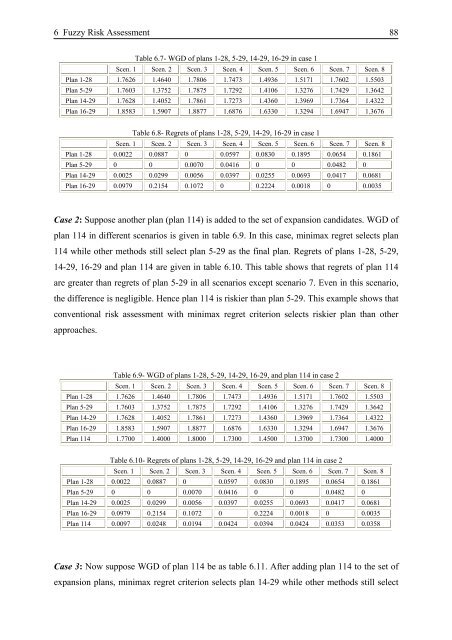Transmission Expansion Planning in Deregulated Power ... - tuprints
Transmission Expansion Planning in Deregulated Power ... - tuprints
Transmission Expansion Planning in Deregulated Power ... - tuprints
You also want an ePaper? Increase the reach of your titles
YUMPU automatically turns print PDFs into web optimized ePapers that Google loves.
6 Fuzzy Risk Assessment 88<br />
Table 6.7- WGD of plans 1-28, 5-29, 14-29, 16-29 <strong>in</strong> case 1<br />
Scen. 1 Scen. 2 Scen. 3 Scen. 4 Scen. 5 Scen. 6 Scen. 7 Scen. 8<br />
Plan 1-28 1.7626 1.4640 1.7806 1.7473 1.4936 1.5171 1.7602 1.5503<br />
Plan 5-29 1.7603 1.3752 1.7875 1.7292 1.4106 1.3276 1.7429 1.3642<br />
Plan 14-29 1.7628 1.4052 1.7861 1.7273 1.4360 1.3969 1.7364 1.4322<br />
Plan 16-29 1.8583 1.5907 1.8877 1.6876 1.6330 1.3294 1.6947 1.3676<br />
Table 6.8- Regrets of plans 1-28, 5-29, 14-29, 16-29 <strong>in</strong> case 1<br />
Scen. 1 Scen. 2 Scen. 3 Scen. 4 Scen. 5 Scen. 6 Scen. 7 Scen. 8<br />
Plan 1-28 0.0022 0.0887 0 0.0597 0.0830 0.1895 0.0654 0.1861<br />
Plan 5-29 0 0 0.0070 0.0416 0 0 0.0482 0<br />
Plan 14-29 0.0025 0.0299 0.0056 0.0397 0.0255 0.0693 0.0417 0.0681<br />
Plan 16-29 0.0979 0.2154 0.1072 0 0.2224 0.0018 0 0.0035<br />
Case 2: Suppose another plan (plan 114) is added to the set of expansion candidates. WGD of<br />
plan 114 <strong>in</strong> different scenarios is given <strong>in</strong> table 6.9. In this case, m<strong>in</strong>imax regret selects plan<br />
114 while other methods still select plan 5-29 as the f<strong>in</strong>al plan. Regrets of plans 1-28, 5-29,<br />
14-29, 16-29 and plan 114 are given <strong>in</strong> table 6.10. This table shows that regrets of plan 114<br />
are greater than regrets of plan 5-29 <strong>in</strong> all scenarios except scenario 7. Even <strong>in</strong> this scenario,<br />
the difference is negligible. Hence plan 114 is riskier than plan 5-29. This example shows that<br />
conventional risk assessment with m<strong>in</strong>imax regret criterion selects riskier plan than other<br />
approaches.<br />
Table 6.9- WGD of plans 1-28, 5-29, 14-29, 16-29, and plan 114 <strong>in</strong> case 2<br />
Scen. 1 Scen. 2 Scen. 3 Scen. 4 Scen. 5 Scen. 6 Scen. 7 Scen. 8<br />
Plan 1-28 1.7626 1.4640 1.7806 1.7473 1.4936 1.5171 1.7602 1.5503<br />
Plan 5-29 1.7603 1.3752 1.7875 1.7292 1.4106 1.3276 1.7429 1.3642<br />
Plan 14-29 1.7628 1.4052 1.7861 1.7273 1.4360 1.3969 1.7364 1.4322<br />
Plan 16-29 1.8583 1.5907 1.8877 1.6876 1.6330 1.3294 1.6947 1.3676<br />
Plan 114 1.7700 1.4000 1.8000 1.7300 1.4500 1.3700 1.7300 1.4000<br />
Table 6.10- Regrets of plans 1-28, 5-29, 14-29, 16-29 and plan 114 <strong>in</strong> case 2<br />
Scen. 1 Scen. 2 Scen. 3 Scen. 4 Scen. 5 Scen. 6 Scen. 7 Scen. 8<br />
Plan 1-28 0.0022 0.0887 0 0.0597 0.0830 0.1895 0.0654 0.1861<br />
Plan 5-29 0 0 0.0070 0.0416 0 0 0.0482 0<br />
Plan 14-29 0.0025 0.0299 0.0056 0.0397 0.0255 0.0693 0.0417 0.0681<br />
Plan 16-29 0.0979 0.2154 0.1072 0 0.2224 0.0018 0 0.0035<br />
Plan 114 0.0097 0.0248 0.0194 0.0424 0.0394 0.0424 0.0353 0.0358<br />
Case 3: Now suppose WGD of plan 114 be as table 6.11. After add<strong>in</strong>g plan 114 to the set of<br />
expansion plans, m<strong>in</strong>imax regret criterion selects plan 14-29 while other methods still select

















